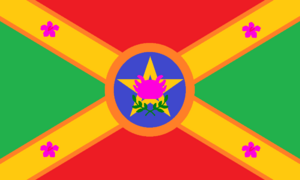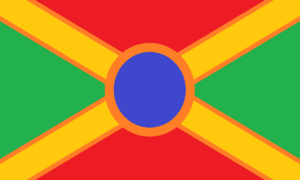Andrendia (Pacifica)
Axolotl Empire of Andrendia Impero Axolotl Di Andrendia | |
|---|---|
Motto: Uniti nelle differenze United in Differences | |
Anthem: [The Empire of Azaleas] | |
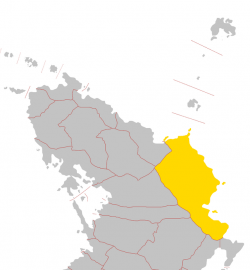 Location of Andrendia in Pacifica | |
| Location | Apennia, between the Apennian Alps in the West and the Eastern Ocean (Tirriatico Sea) in the East. |
| Capital and largest city | Andreopolis |
| Official languages | Apennisea |
| Recognised national languages | Austral |
| Religion (2025) | Azaelism 45,3%
Christianity 8% Cult of Axolotls 6,7% Islam 4,9% Not Religious/Atheist 35.1% Other 3,1% |
| Demonym(s) | Andreian |
| Government | Constitutional Monarchy |
• Emperor | Andrea Oloto VII |
• Prime Minister | Giacomo La Greca |
| | |
| Legislature | Parliament |
| Senate | |
| National Assembly | |
| Formation | |
• Unitication of the Pre-Axolian States | July 23rd 1496 |
• Creation of the Axolotl Empire of Andrendia | November 30th 1577 |
• End of the Andreian Civil War and proclamation of the Constitutional Monarchy | July 20th 1807 |
| Area | |
• Total | 532,110 km2 (205,450 sq mi) (4) |
| Population | |
• 2025 census | 120,220,056 (4) |
• Density | 227.77/km2 (589.9/sq mi) (22) |
| GDP (nominal) | estimate |
• Total | $5,31 Trilion (5) |
• Per capita | $44,169 (15) |
| HDI | 0.869 very high · 14 |
| Currency | Andreian Brick (ABR/₿) |
| Time zone | UTC+2, +3 |
| Date format | dd/mm/yyyy |
| Mains electricity | 230 V–50 Hz |
| Driving side | right |
| Calling code | +39 |
| World Forum Code | AD |
| Internet TLD | .and |
| |
Andrendia, officially the Axolotl Empire of Andrendia, is a unitary state located in North-Eastearn Bailtem bordered in the West by Kustannuksa and the Central Bailtemmic Republic and in the north by New Altnavia. The Country is mostly located in Apennia, the geographical region located between the Apennian Alps and the Tirriatico Sea. It owns the 4 major and many minor islands of the Apennic Archipelago. It's the fourth largest and fourth most inhabited country in the South Pacific and is considered a strong player in the region. The largest city is the country's Capital, Andreopolis.
The country is a Constitutional Monarchy and its current Emperor is Andrea Oloto VII. The head of government is Prime Minister Giacomo La Greca. The Official Language is Apennise, with Austral recognized as a Minor Language. Aranzian, Herculanean and Portian are co-official in the Regions they're spoken in. The country has no state religion but the most common is Azaelism. The Empire is a founding member of the Bailtemmic Cooperation Organization.
Before the proclamation of the Axolotl Empire of Andrendia by Franco Oloto in 1577, the vast majority of the current territories of the nation were part of the Axolian Empire.
Etymology
Andrendia derives from the name of the second Emperor of Andrendia, Andrea Oloto I, son of the first Emperor and Prophet Franco Oloto I. He named the Empire after his newborn son. Basically, the name means "Land of Andrea".
History
The history of Andrendia is divided by historians in 7 Eras, 8 including Prehistory.
Prehistory
Humans arrived in Apennia around 15,000 BCE and established themselves in the south of the Great Apennian Plains, especially around the Magazo Jungle. The Ancient Apennians lived as nomads until around 9,000 BCE, when, according to archeological findings, the first permanent settlements started being constructed, mostly around the swamps of the Apennian Plains. During this period going from 9,000 BCE to 3,000 BCE, the ancient inhabitants of the Magazo Jungle began treating the endemic Axolotls as divine creatures due to their regenerative abilities, beginning the Cult of Axolotls.
Ancient Era (Circa 3,000 BCE-686)
Second wave of immigration into Apennia
Around 3,000 BCE another group of humans, that spoke a language tied to Montacian, entered Apennia. The Ancient Apennians and the New Apennians wouldn't begin to blend togheter immediately. Around 1,700 BCE the first written language of Apennia was conceived. The language, known now as Proto-Apennian, would end up evolving into the current languages of the region.
The first political entities of the region
After 1,700 BCE, the New Apennians began spreading more in the region, beginning the foundations of the great entities of the Ancient Era, the Vulcanbonian Kingdom and the Axoland Kingdom. In the north, the Vulcanbonian Kingdom was founded around 820 BCE and was composed mostly of New Apennians and followed a polytheistic religion, believing in Warrior Gods living on Mount Vulcanbon, an important volcano in the area. Alongside their fighting spirits, the Kingdom was also home to art and philosophy, with the region being the home of the first epic poems of Apennia, the Volumbian Cycle, named after the Vulcanbonian capital of Volumbiæ. In the south, the Axoland Kingdom was founded around 750 BCE and was composed mostly of Ancient Apennians and followed the Cult of Axolotls, with an entity known as the "Axo-King" ruling the country as a god king. Like the Vulcanbonian Kingdom, the Axoland Kingdom was known for its art and philosophy, that, unlike the Vulcanbonian one, talked way more about the divine origin of the world. The Kingdom's capital was Axolia, now Andreopolis, founded in 691 BCE. Other minor entities were founded along the Apennian Alps and the Magazo Jungle, which quickly aligned, diplomatically or otherwise, with the two great powers of the region. Most of these entities were still partially tribal, while others were primitive monarchies. In the more arid region south of the Magazo Jungle, the nomadic groups of the area, mixed between New and Ancient Apennians, united into the Republic of Arancio, known for its marvelous architecture, mostly notable in their capital, known by archeologists today as Grand Arancia, and metallurgy.
Vulcanbonian-Axolandian War
The two Kingdoms coexisted for many centuries until, around 675, began having tensions on their shared border for reasons that arechologists attribute to the founding of a Vulcanbonian city on Axolandian territories, probably caused by a mapping error. In 682, the Axolandians attacked the settlement, beginning the Vulcanbonian-Axolandian War. The war lasted just 4 years, an incredibly short time for a War during the first millenium, and was brutal. The Axolandians won the war, devastating the rival kingdom and its allies, but soon collapsed itself due to internal conflict and rebellions. The war had huge consequences on Apennia, with the collapse of the two main powers of the region and the destruction of the land caused by the War and the following rebellions. One of the most important consequences of the conflict was the beginning of the destruction of the Vulcanbonian Religion, that was quickly replaced by the Cult of Axolotls, with the exclusion of one minor cult in the Religion, the cult of the Flower God Azaleo, which briefly kept existing on Azalea Island, after the exile of its followers to it a century before the war, and that would in the future become Azaelism. The only nation that was unaltered in the war was the Republic of Arancio, that remained neutral.
The end of the War marked the end of the Ancient Era and the start of the Middle Era.
Middle Era (686-1387)
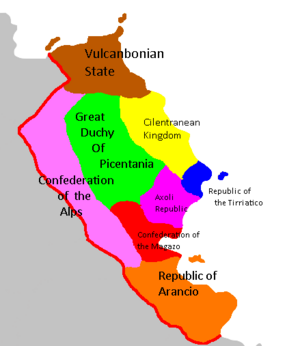
The Middle Era's Power Vacuum
After the end of the war, for around four centuries, there was a power vacuum in Apennia with no nations, other than the Republic of Arancio, that were able to remain stable. In 1043, this period of chaos ended after the proclamation of the Axoli Republic, direct successor of the Axoland Kingdom. In the following years, other countries were established that were able to be stable enough to keep existing for many years.
These countries were:
- The Great Duchy of Picentania, a country controlling the water-rich plains now known as the Great Apennian Plains.
- The Confederation of the Alps and the Confederation of the Magazo, two confederations of smaller states located on the Alps and in the Magazo Jungle, united by the dream of becoming strong players in the future of Apennia.
- The Cilentranean Kingdom, a monarchy established by an unknown man that proclaimed to be a descendant of the Vulcanbonian Warrior Gods.
- The Republic of the Tirriatico, a small Republic founded by a group of merchants. Their capital of Granporto quickly became an important trading spot in Apennia, thanks to its immediate access to the Tirriatico Sea, from which the country took its name.
- The Vulcanbonian State, founded by a descendant of the last Vulcanbonian monarch who proclaimed himself dictator of the area. The country claimed many territories that it actually didn't control, since the State's military was often forced by the Dictator to station around the capital of Volumbiæ, even if the country wasn't at war.
Meanwhile, the Republic of Arancio kept thriving. During the 9th century, Christian missionaries arrived in the Republic and convinced the Leader of the Nation to convert its people into Christianity.
Early Axolian Era (1387-1496)
Transformation of the Axoli Republic into the Axolian Empire
In 1387, descendants of the Axoland crown took control of the Axoli council and proclaimed the transformation of the country into the Axolian Empire, with the plan of reuniting all of their ancient lands under their rule.
This event marked the start of the Early Axolian Era and of the Axolian Unification Wars.
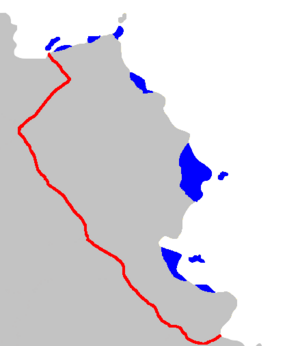
The maritime supremacy of the Tirriatican Empire
In 1403 the Republic of the Tirriatico, after a vote at their council, became the Tirriatican Empire and started using their maritime supremacy over the Apennian seas to set shops and colonies along the coasts of Apennia. Their invasion of Vulcanbonia started the slow collapse of the Vulcanbonian State.
The Empire's fast ships let them trade with nations all over Pacifica, becoming one of the biggest traders in the South Pacific' Eastern coast
During the Age of Piracy their outposts will be used by the pirates as bases.
Axolian Era (1496-1577)
The Unification under the Axolian Empire
In 1496 the Axolian Unification Wars ended, unifying almost all of the Nations of Apennia, diplomatically or militarily, under the Axolian Empire.
This event marked the start of the Axolian Era.
Early Andreian Era (1577-1798)
The Tale of Franco Oloto
In 1577, the explorer Franco Oloto, discoverer of the ancient ruins around Mount Vulcanbon, decided to explore the mysterious Azalea Island, off the shore of Vulcanbonia. The island was never actully explored, since ancient Vulcanbonian legends say the island was cursed and dangerous. The Explorer ignored the warnings and decided to explore the island. On the island he found ancient ruins from a previously unknown civilization. What actually happened on the island is unknown, but we know that after Franco Oloto returned to the mainland, after over a month on the island spent translating ancient texts, he started talking about an ancient cult. He then went to Axolia, the capital of the Axolian Empire, and started talking about this religion, saying he was its Messiah. A few started listening to him but many started attacking him and thinking he was crazy. Then something unexpected happened, a great light appeared in the sky. Franco Oloto yelled to the now large mass of people that the light was a sign of the religion's god, Azaleo, the "God of Flowering Azaleas". That mysterious event, now theorized to be an unusual weather event, was known to history as the Miracle of Axolia.
Some days later the Emperor was overthrown by the people and Franco was crowned Emperor. He then proclaimed the foundation of the Axolotl Empire of Andrendia, called like this in name of his son, Andrea Oloto, with Azaelism as its official religion.
This event marked the start of the Early Andreian Era.
Beginning of Kustannuksan-Andreian Relationships
In 1584, Kustannuksan Ambassadors crossed the Apennian Alps and reached the capital of Andreopolis. The Kustannuksan had contacts with the Pre-Axolian States and the Axolian Empire in the past, but relations were never normalized. With this diplomatic trip Andrendia and Kustannuksa became close allies. Three months later, Andreian Ambassadors arrived in the Kustannuksan Capital of Pohjoinen. In 1585 the Emperors of the two countries met agreed on treaties that are still the basis of the current Kustannuksan-Andreian Alliance.
Spreading of Azaelism across Andrendia
After the Miracle of Axolia, Azaelism became the official religion of the country and to spread it, from 1578 to 1604, the Azaleo's Squadroon, a religious group founded by Franco Oloto, started to spread Azaelism across Andrendia. The Squadroon didn't force people into believing the religion, by the order of the Emperor to respect the Axolians, but still tried to spread it as much as possible. Though, there were many episodes where members of the group committed violent attacks against Axolians and other Non-Azaelists.
In 1604, after a massacre of Axolians that refused to believe in Azaelism caused by members of the Squadroon, Empress Maria Oloto I dissolved the group, proclaiming that the religion was present enough in the Nation and that atrocities like this were inhumane and that they should stop.
Andreian Era (1798-1887)
Invasion of the Republic of Arancio
In 1798 the last Pre-Axolian State, the ancient Republic of Arancio was invaded by the Empire after the Arancian border guard accidentally attacked a carriage that was taking Andreian diplomats to the Arancian capital of Val D'Arancio. The war only lasted a month and it was a major Andreian victory. The newly annexed territories became the Autonomous Region of Arancio, that, like Vulcanbonia, received its autonomy due to its long history of independence from powers coming from the center of Apennia.
This event marked the start of the Andreian Era.
The Dark Ages of the Andreian Era
"The Dark Ages of the Andreian Era" is a term used to define the rule of Emperor Franco Oloto III. During his rule, the emperor installed many policies that limited the belief in the Cult of Axolotls, the autonomy of the regions and many of the people's freedoms.
Living in this period of history is often defined as one of the worst times to live in Andrendia.
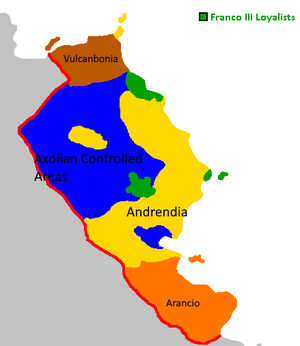
Andreian Civil War
On July 14th 1802 Andrendia saw the start of a civil war. After the many tensions between the Axolian population and the Empire, the Emperor Franco Oloto III was killed by an Axolian extremist.
The war was fought between five different factions:
- The Axolian Faction, tired of the Emperor's policies, they wanted to take control of Andrendia and get revenge on the Azaelists.
- The Andrea Oloto IV Supporters, who supported the government of the new emperor and wanted to bring peace back to the nation.
- The Franco III Loyalists, the few who believed into the assassinated Emperor's ideas and wanted to install a new regime following said ideas.
- The Arancian and Vulcanbonian Independentists, that after the removal of their autonomy wanted their Independence back.
Immediately after the assassination, Axolians started to rebel and take control of large areas of the country. Meanwhile the new government rushed to stop the rebels and took immediate control of Azalea Island, to stop the likely planned devastation of the Temple.
On December 22nd 1802 Northern and Southern Andrendia declared Independence from the Empire and started fighting against both the Empire and the Axolians.
Then, between the March of 1803 and the February of 1804, one of the most brutal events of the War happened. In Picentania, in a large pocket of land controlled by the Empire but surrounded by the Axolians, massive attacks happened, mostly killing civilians. The survivors of the attacks were then took to the biggest city near the Exclave, Collinetia, to be tortured and killed. Houndreds of innocent people were killed in the city. Collinetia would be renamed Picentia after the war in name of the civilians that lost their lives in the city.
On February 4th 1804 a massive attack from the Empire attacked the city, discovering and stopping the massacres. Axolian generals declared that this was a revenge for the attacks made by the Azaleo's Squadroon against Axolians.
On the 1st of May 1804, on the coast of Cilentranea, Emperor Andrea Oloto IV signed a peace declaration with the Franco III Loyalists, that joined the Empire and started helping it to stop the Axolian Faction and the Independentists.
During all of 1805 the Empire made countless attacks in Vulcanbonia to stop the secessionists, capturing their capital and annexing them on October 17th.
Then on January 8th 1806 a delegation from Arancio sent a request to reunite with the Empire, but keeping their autonomy. The Empire accepted the request.
On the 15th of July 1807 the Great Battle of Andreopolis was fought. The Axolians attacked Andreopolis on the first lights of the day, surprising the population. They burned the Emperor's Palace and destroyed many Azaelist Churches. Some hours later the Empire's counterattack devastated most of the Axolian army and then emperor Andrea Oloto IV killed the leader of the Axolian Faction, after he shot him in the arm.
Finally on the 20th of July 1807, the Emperor signed a peace treaty with the generals of the Axolian Faction declaring the complete reunification of Andrendia and the end of the war.
And on September 1st, Emperor Andrea Oloto IV declared that the Axolotl Empire of Andrendia would become, from that day onwards, a Constitutional Monarchy, with the reason behind the decision being that the absolutism had brought Andrendia into the Civil War and that, with more say from the popoluation, similiar events may be prevented. The new Parliament would've been elected for the first time on January 1st 1808. His second and last decision as an absolute monarch was the nullification of all policies installed by Emperor Franco Oloto III and restoring autonomy in Northern and Southern Andrendia.
Andrendia after the Civil War
On December 3rd 1839, the first railway in Andrendia, the Trenia-Andreopolis railway, was opened.
In 1860 the Great Reclamation Project started, removing the entirety of the Swamps in the Great Apennian Plains.
In 1864 Andrendia partecipated to the negotiations of the Grovne Conventions.
On July 8th 1887, the Andreian Parliament approved a law that let everyone, including women, have the right to vote in all elections.
The introduction of Universal Suffrage marks the end of the Andreian Era and the start of the New Andreian Era.
New Andreian Era (1877-Present Day)
The Start of the Great Reformer's reign
In 1921 the recently on power Emperor Franco Oloto IV, known as the Great Reformer, helped the newly formed Andreian Socialist Party concept a new economic system for the country, thanks to the socialist ideals he heard of during his youth. The Party then was able to take the reforms to the parliament and they were made law on March 9th of the same year, with great satisfaction from the Emperor. This support for the workers' cause made him really popular.
On August 23rd 1925 the Block River Dam was completed, the area that became the Block Dam Lake completely filled with water in 1949
The Great War and the Iron Century
Through the entirety of the Great War, Andrendia remained as a non-belligerent neutral power. The country entered this position due to being a Democratic Empire and having economic ties with both fronts of the war due to this. During the War, Andrendia sent aid to both sides of the war, with the idea of keeping good ties with both sides, regardless of who would’ve won the war. This plan worked until 1951, when the Minister of Defence approved Operation Doublefront (Operazione Doppiofronte), which comprises the organization of recruitment centers where volunteers could recruit themselves in various groups which would’ve gone fighting for both fronts, some with the Allies and some with the Imperialists. The small armies that formed from the Operation were sent to help the two sides, keeping in secret that Andrendia was technically fighting for both sides at the same time. In various fights though the voluntary groups ended up fighting against each other and the Operation was deemed a failure. The powers of both sides lost all trust in the Axolotl Empire of Andrendia and the Empire was sanctioned after the war and remained isolated.
During the Iron Century, Andrendia tried to mediate between most crises and wars, to gain back trust and gain new allies and trade partners, plan that ended in a success.
On September 9th 1968 the first Andreian Nuclear Bomb completed its construction and its test then followed in a unhinhabited region of the Southern Mesa the week later. Both the construction and the test of the warhead caused major public outrage. Nonetheless, the Andreian Atomic Program proceeded normally, with several new warheads being developed throughout the rest of the Cold War.
The Andreic Miracle
From 1971 to 1985 Andrendia went through is known as the Andreic Miracle, sprung by the discovery of new rare earth and hydrocarbon deposits across Aranzia, much needed in the ever expanding global economy. During this period the country's GDP grew to unseen heights and the country managed to make new economic and military allies. Life in the Empire also changed with several reforms and projects directed at the country's citizens being made by the government thanks to the economic growth of the nation.
In 1972 the Parliament passed the law to establish the region of Capitalia, to better govern the ever-growing capital city. In June 1973 the region was officially established.
On February 15th 1973 Franco Oloto IV founded the Andreian Space Agency and some day later, after a National Referendum, Andrendia joined the CPSC.
On June 18th 1985, Emperor Franco Oloto IV died of cancer, with his successor Alfredo Oloto II taking his place. The death of the Emperor is regarded as the end of the Andreic Miracle.
Modern Day Andrendia
Throughout the late 80s and the early 90s the highways and railways of Andrendia were completely renovated and expanded, bringing the Empire closer togheter. The greatest achievement was in 1991, with the first high speed train in Andreian History being constructed. The first line to be upgraded to high speed capabilities was the one between Andreopolis and Faiano, the first railway line in the country.
On April 10th 2002, gay marriage was legalized, being the starting step to the current acceptance of LGBTQ+ people in Andrendia.
In 2008 Andrendia and other Bailtemmic countries founded the Bailtemmic Cooperation Organization.
Geography
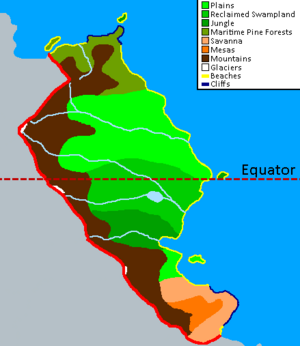
Physical Geography
Andrendia has a large variety of environments, going from arid mesas to intricated jungles to large plains to high mountain peaks.
The major mountain range of the country is the Apennian Alps. Filled of volcanic activity, the mountain range has some of the highest mountains in Bailtem, like Shimmer Peak, Mt. Brick and Mt. Block. Located on the west of the nation, these mountains always signed the borders of Apennia and its states. In the North-Eastern range of the mountain chain is located Mt. Vulcanbon, the largest active volcano in the Country, Mount Aether, famous for the clouds who constantly cover its peak and Andrea Oloto II Peak, named after the Emperor who died on it. Around the range, large maritime pine forests cover the area. In the south, we find the Arancio Mesa, an arid and resource rich area full of eroded peaks and flat hills. The rivers that form from the glaciers of the mountain chain form the Great Apennian Plains, most important part of Apennia and most populated area in Andrendia. In the past this area was full of swamps and lakes, but many reclamation projects made the area habitable. This projects lead to the construction of the Block River Dam, biggest dam of the country. The damn produces energy for all of the surrounding areas, including the capital of Andreopolis. The dam generated the Block Dam Lake, the biggest lake in Andrendia. The southern part of the Plains is occupied by the Magazo Jungle, the biggest Jungle in Andrendia and a protected area due to its biodiversity and beauty. In the east, we find the coasts, in Northern and especially in Southern Andrendia they're high and rocky, while in the center they're low and sandy. Andrendia's entire coastline leads to the Tirriatican Sea, which spans from the coasts of Apennia to the start of the Eastern Ocean.
Political Geography
First Level Subdivisions
The Country has 11 first level subdivisions: 2 Autonomous Regions, 3 Island Regions, 5 Standard Regions and the Imperial Region of Capitalia, which houses the capital of the country, Andreopolis and its metropolitan area.
All Normal and Island Regions are ruled by a Regional Council, with a Regional Governor as the most important political figure in each Region. In the Autonomous Regions the Council is replaced by a Regional Parliament and the Governor by the Regional President.
Capitalia is directly ruled by the National Parliament.
Standard Regions
Standard Regions have little autonomy and the Regional Councils can only decide about the region's infrastructures and public services.
Andro
Andro, commonly known as the Mountainous Frontier, is the Westernmost region of Andrendia. The region is almost entirely occupied by some of the highest peaks of the Apennian Alps, with only a few flat areas on the eastern part of the region. In this area are located the largest inhabited centers of the region, the capital of Azalì, known for its beautiful Azaelist Church, and the town of Picentia, named after the Picentanian Azaelists deported there during the Civil War. The third biggest town in the region, Valle Aurea is located in the hills of the North of the region, on the Aureo River and is famous between Alpinists due to its closeness to Mount Aether.
Brickia
The region of Brickia is the most inhabited in the Country, thanks to its large plains and water presence. The main cities in the region are Faiano, the regional capital and largest producer of the Andreian Potato, Trenia, home of the Andreian Railways, and Eolia, famous for its large wind power industry. The region is crossed by the two major rivers of the nation: the Brick, which flows to the national capital and then into the Sea, and the Block, that stops at the Block Dam Lake, a lake located in what once was the Central Brickian Depression, turned into a lake by the Block River Dam, that supplies the region with energy. The river then flows into the Brick via artificial canals.
Cilentranea
Cilentranea, smallest of the Standard Regions, is located on the coast between Capitalia and Picentania. The region has large sandy beaches, that attract a lot of tourists, main source of the regional wealth. The main inhabited centers are the capital of Cilentina, touristic city located on the mouth of the Picentino, and Granporto, ancient capital of the Tirriatican Empire and largest port in the country.
Picentania
The region of Picentania is a mostly flat region located between Northern Andrendia and Brickia. The region is named after its main river, the Picentino. The main inhabited centers are Pontinia, regional capital and location of an ancient arch bridge, Sala, an agricultural town famous for the production of the Picentanean Cheese, and Val Fiumara, located where the Aureo River joins the Picentino. Along the northern border of the region, on the North-Eastern Range of the Apennian Alps, is located Andrea Oloto II Peak, named after the homonymous Emperor, who died on the mountain in 1711.
Magazena
The Magazena Region is named after the Magazo, a river that flows into the Gulf of Axolotls, the largest gulf in the nation. The region is covered by the largest jungle in the country, the Magazo Jungle. The areas not covered by the jungle are where most of the population is located. The main inhabited centers are Pastoria, the capital of the region, founded by shepherds centuries ago, Fabraica, the industrial heart of Andrendia, located on the hills near Mount Shimmer, the highest peak in the country, and Axolotlia, main port in the Gulf of Axolotls and second largest port in the country. On the Apennian Alps, is located the dormant volcano of Sulphurous Mountain, largest sulphur deposit in the Empire.
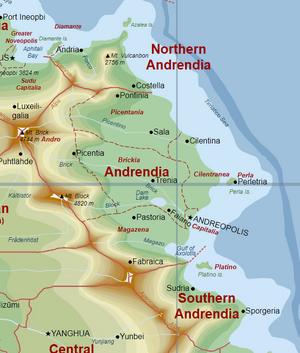
Island Regions
The Island Regions have higher autonomy than Standard Regions, due to their small size and population and to their need of periodic sea transport from and to the mainland.
Diamante
The island, located off the coast of Northern Andrendia, is home to a small diamond mind. The only inhabited center of the island is the village of Diamantia. The main attraction of the village is the Diamond Mining Museum, where the centenary history of the island's diamond mines is preserved. The mine nowdays is only maintained for geologic research, as the mine is almost fully exhausted. The mine and surreal landscape caused by its operations, like the odd sight of an almost total lack of trees on a tropical island, are a minor tourist attraction on their own. The government is currently trying to bonify and repopulate the island, alongside construction of a new cargo harbour in Diamantia to try and revitalize the island's economy.
Perla
The island Region of Perla is famous for its sparse jungle and is a highly seeked tourist destination due to its fine white sands, great food and the extensive pearl farming industry of the island, giving it its famous place in the jewelry industry.
Platino
This region, located off the coast of Magazena and Southern Andrendia, was known known for its rare mineral rich craters, created by an ancient asteroid impact. After they ran out in the early 70s the Andreian Space Agency decided to establish labs on the island to study the asteroid impact zone and ended up being granted over half of the island from the government. The only inhabited center on the island is the town of Platiniano, previously a mining village, now home of the space program. Many inhabitants of the island are workers of the Space Base. Launches are frequent due to the high request of new satellites in orbit. International missions to the other planets of the system also depart from here.
Autonomous Regions
The Autonomous Regions have the highest power of all Regions in Andrendia. They have been granted autonomy due to the long history of independence and due to their special needs in education and infrastructure, due to the majority of their inhabitants speaking the regional language alongside Appenise. Their Regional Parliaments can also decide some Region specific laws if they need to.
Northern Andrendia/Vulcanbonia
The Autonomous Region of Northern Andrendia, also known as Vulcanbonia, is home to the largest active volcano in the Empire, Mount Vulcanbon, famous for the ruins of the ancient Vulcanbonian capital, Volumbiæ, located around its sides. The mountain divides the region in half. In the Western part, large maritime pine forests occupy most of the environment. The eastern part, on the other hand, is very similar to Cilentranea. The main inhabited centers are Costella in the East and Andria, the regional capital, in the West, on the mouth of the Forco River. On the northernmost part of the region is located the small town of Punta Azalea. Off the shore of the town is located Azalea Island, location of the mysterious Azalea Temple and other ruins of the still unknown to this day civilization that inhabited the island. Due to the religious correlations of the island with the Azaelist religion, the island is a place of worship and pilgrimage visited by tens of thousands of people every year.
Southern Andrendia/Arancio
The Autonomous Region of Southern Andrendia, also knwon as Arancio, is home to the largest desert in the country. The region's alternative name comes from the Arancian people, who inhabit the region since prehistory, and are named in turn after the color of the large mesas located in the region's center. In the south of the region, the coast becomes extremely steep and rocky. The region's southern border cuts through the Argen River, named after the, now exhausted, silver mines of the area. The Arancian range of the Apennian Alps is one of the most inhospitable, with Forlorn Peak named after the many people who died climbing it. Mount Arancio on the other hand is a sacred site to the Arancian People and many visit it every year. The main inhabited centers are Sudria, the regional capital, located in the less arid area of the country, Sporgeria, locatred on one of the steep cliffs of the region and Val D'Arancio, ancient capital of the Arancio Republic, located in the mesas. Going south from the regional capital, the climate becomes hotter and the environment transforms from a plain to a large prairie full of shrubs and cacti. Around the center of the region, the praire becomes a desert, famous for its giant Mesas. The desert is extremely resource rich, especially in oil and natural gasses, that are the main source of the region's economy.
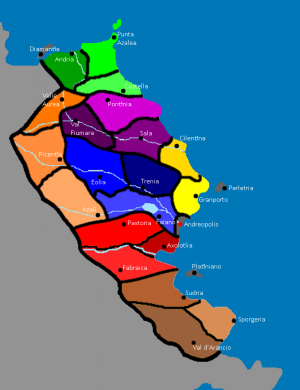
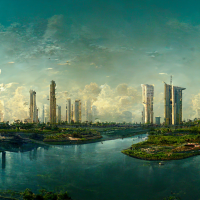
Imperial Region of Capitalia
The Imperial Region of Capitalia is a Special Region comprising the National capital of Andreopolis and the sourrounding metropolitan area.
Second Level Subdivisions
Every First Level Subdivision in Andrendia, with the exceptions of the Imperial Region of Capitalia and the Island Regions, have Second Level Subdivisions, known as Provinces. There are a total of 20 Official Provinces in the country. The Regions without Provinces, due to also serving the roles a province would alongside their Regional ones, are counted as Special Provinces, taking the total amount of Provinces to 24.
The provinces serve to take to the Regional Councils and Regional Parliaments the local problems of the areas and to have more specific decisions over infrastructure and public services than the Regions.
| Region | Provinces in the Region | Regional Capital |
|---|---|---|
| Andro | Province of Valle Aurea, Province of Picentia, Province of Azalì | Azalì |
| Brickia | Province of Eolia, Province of Trenia, Province of Faiano | Faiano |
| Capitalia | Special Province of Andreopolis | Andreopolis |
| Cilentranea | Province of Cilentina, Province of Granporto | Cilentina |
| Diamante | Special Province of Diamantia | Diamantia |
| Magazena | Province of Pastoria, Province of Fabraica, Province of Axolotlia | Pastoria |
| Northern Andrendia/Vulcanbonia | Province of Andria, Province of Costella, Province of Punta Azalea | Andria |
| Perla | Special Province of Perletria | Perletria |
| Picentania | Province of Fiumara, Province of Pontinia, Province of Sala | Pontinia |
| Platino | Special Province of Platiniano | Platiniano |
| Southern Andrendia/Arancio | Province of Sudria, Province of Sporgeria, Province of Val d'Arancio | Sudria |
Politics
The Axolotl Empire of Andrendia is an Unitary Constitutional Monarchy, with Emperor Andrea Oloto VII as its current monarch and Giacomo la Greca as its Prime Minister. The Empire has been a Constitutional Monarchy since the end of the Andreian Civil War, after Emperor Andrea Oloto IV proclaimed the end of Absolutism in the country.
Government
Andrendia has a bicameral parliament, composed of the upper house, the Imperial Senate, that meets in Palazzo Colonnato, and the lower house, the Andreian National Assembly, that meets in Palazzo d'Equatore. The two houses have the same powers. The Prime Minister is the head of government of Andrendia and is appointed, alongside the cabinet, by the Emperor and have to pass a confidence vote in the parliament to come in office.
Foreign Relationships
Andrendia is a member of the World Forum, with Angelio Villarì as its ambassador.
The Empire has also had a long lasting alliance with the neighboring Kustannuksan Empire for over a houndred years, especially due to the country's large Andreian minority.
Military
The military history of Andrendia goes back to the Ancient Era, with all sort of military conflicts happening from then onward, from the Great Wars of the 7th century to the expansion of the Axolian Empire, the Andreian Civil War, the Great war and the countless operations after.
The Andreian Army, Royal Navy, Air Force, and Carabinieri collectively form the Andreian Armed Forces, under the command of the Council of Defense, presided over by the Minister of Defense and the Prime Minister, with even the Emperor gaining some powers over it in extreme cases voted by the Parliament. According to the constitution, the Parliament has the authority to declare a state of war and vest the necessary war-making powers in the government. The entire Armed Forces were fully reformed during the Cold War after the fiasco of Operation Doublefront.
The Andreian Army is the ground defense force of the Empire and is the successor to the Axolian Imperial Army and the many others preceding it. Its century-long history gives the Army a great prestige in the global community, even while having mostly fought local wars. Today the army is equipped with modern tanks, infantry fighting vechicles, attack helicopters and tank destroyers.
The Andreian Royal Navy is a blue-water navy and, like the Andreian Army, is the successor of the Axolian Royal Navy. The Navy operates all over the world in peacekeeping operations and operates around 200 vessels of all sizes. The most important vessels of the navy are its 3 aircraft carriers and various nuclear submarines.
The Andreian Air Force was founded in 1923 and currently houses over 200 planes. The acrobatic display team is the "Fulmini Andreiani" ("Andreian Lightnings").
Andrendia has been a recognized nuclear state since 1968 and is part of various nuclear treaties. The Empire houses around 70 nuclear warheads.
The Carabinieri are an autonomous corps of the Armed Forces and the gendarmerie and military police of the Empire.
Economy
The Andreian Economy is a mixed economy, with a good percentage of companies and industries being owned directly by the government but still keeping a free market system. The Nation's economy is led by tourism, mining, agriculture, production of electronics and fossil fuel extraction.
Mining
Mining operations have always been one of the largest economic resources of Andrendia. Even with operations dating centuries, most veins across the country still house enough ore to last for at least 300 years on average. Large deposits of rare earth metals are found in Andro and on the island of Platino. Tungsten, copper, iron, silver and other commonly used metals are extracted in the mesas of Aranzia. Diamonds are mined on Diamante island, mostly used for jewelry due to the small capacity of the mine.
Hydrocarbons
Hydrocarbons, mostly oil and methane are extracted in Aranzia and in the Tirriatico Sea. Oil wells in Aranzia have been known since prehistory and were used for ancient medicinal applications. Oil is refined on the shores of Magazena and exported via sea across all of Pacifica.
Tourism
The historic and natural beauties of Andrendia make tourism the biggest economic resource of the country, with millions of tourists visiting the Nation every yea. Sitting on the equator, its warm climate attracts tourists from all over Pacifica. The beaches of Perla are especially seeked by tourists due to their fine sands and coral reefs.
Agriculture
Andrendia produces large amounts of crops and other agricultural products thanks to its large plains. Most organic goods made for exporting are moved to the large seaports on the Tirriatico via the vast waterways of the nation.
Transport
The Empire is renowned for its infrastructure across all of Bailtem.
Andrendia was one of the first countries to establish a motorway system, the autostrade, reserved for fast traffic and motor vehicles. A wide system of roads covers the Empire, with almost its entirety being state owned. The longest and most important artery in the country's road system is the A1 Andria-Sporgeria, running through the center of the country connecting the north and south.
The railway system, mostly controlled by the Andreian Railways (Ferrovie Andreiane) has been active since 1839 and connects the majority of the country. High speed services, first established in the 90s, now connect most major cities and the borders of the country, especially towards Kustannuksa. Cargo transport mostly runs on dedicated lines or tracks to avoid slowdowns in services.
Thanks to the wide network of navigable rivers and canals and access to the Eastern Ocean, Andrendia possesses an equally wide system of waterways. Much of Andrendia's agricultural products travel by boat and thousands of people take ferries along the rivers and coasts every day. The ports in Granporto and Axolotlia are some of the most active on the continent.
While internal air travel is usually not preferred over high speed trains, airports in Andrendia are still incredibly busy, between the large influx of tourists during all of the year and large airlines having hubs in the Empire. Andrendia's flag carrier airline is Imperial Andreian Airlines, or CAI (Compagnia Aerea Imperiale), has its headquarters at the Franco Oloto IV International Airport in Faiano.
Demographics
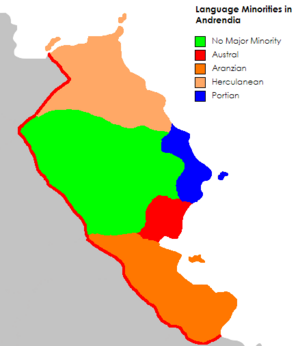
Andrendia has a population of 120.220.056 inhabitants unequally divided across the nation.
| Region | Population | % |
|---|---|---|
| Brickia | 25.246.212 | 21% |
| Picentanea | 22.721.591 | 18,9% |
| Capitalia | 18.634.109 | 15,5% |
| Magazena | 15.628.607 | 13% |
| Cilentranea | 12.623.106 | 10,5% |
| Northern Andrendia | 10.218.705 | 8,5% |
| Andro | 9.016.504 | 7,5% |
| Southern Andrendia | 5.530.122 | 4,6% |
| Perla | 360.660 | 0,3% |
| Platino | 180.330 | 0,15% |
| Diamante | 60.110 | 0,05% |
| Total | 120.220.056 | 100% |
Languages
The Official Language of Andrendia is Appenise, with Aranzian, Portian and Herculanean as National Languages. Austral is also recognized as a National Language, due to the big Austral speaking minority in the "Austral Belt", located between Capitalia, southern Brickia and eastern Magazena.
Religion
The National Religion is Azaelism. This Religion was rediscovered by the first Emperor of Andrendia, Franco Oloto I, after it being lost to time after the end of the Civilization of Azalea Island. Even if the majority of the Andreian polutation is religious, Religion isn't as prevalent in daily life as in the past. Other Religions present in the country are the endemic Cult of Axolotls, Christianity, present especially in the Aranzian inhabited areas, and Islam.
Almost 40% of the country's population is Atheist/Non-Religious.
Culture
Food
Typical Andreian dishes are Pizza, famous all over the world and coming from Vulcanboia, Pasta, made with grain grown in the Apennian Plains since antiquity, Andreian Mashed Potatoes, made with an ancient recipe from Faiano, the Picentanean Cheese, produced with the milk of the cows of Picentania following a production method with ancient origins.
National Symbols
The National Animal of Andrendia is the endemic Axolotl, existing in the country for millions of years and being venerated, even to this day, by the Cult of Axolotls.
The National Flower and Plant is the Azalea, specifically the Andreian Azalea, flower with extremely important religious symbolism to the Empire, due to Azaelism being its major and Official Religion. Andreian Azaleas are endemic to Point Azalea and Azalea Island, where huge bushes of them are extremely common in the small jungle that covers the two areas.
Regional Symbols
Each Region of the Empire then has a Regional Symbol, a specific symbolic element of the Region, ranging from Natural Beauties to Buildings to Food.
Andreians Abroad
Many Andreians across history emigrated the Country, especially in bordering Countries. The largest Andreian community outside of Andrendia is in Kustannuksa, with its origin in the Andreian Civil War, when many inhabitants of Andro decided to cross the Apennian Alps to safety in the neighboring country. Today, many Andreians still live in the country, with some, like Carlo Adamo De Courantis, President of the Kustannuksan Imperial Senate, getting high position in the bordering Empire's government.
Many smaller communities of Andreian immigrants exist all over Pacifica, mostly concentrated in Bailtem.
Trivia
- The current Axolotl population of Andrendia is over 1.500.000, with the most living in the lakes of the Magazo Jungle.
- Mount Block is named after the salt crystals that are found under the mountain, found in shapes similiar to cubes and blocks.
- In Apennise, some of the Mountains, Rivers and even one of the Regions and the Currency have different names, here's a list of the differences.
| Austral Name | Apennise Name |
|---|---|
| Mt. Brick | Mt. Bricco |
| Mt. Block | Mt. Blocco |
| Brick River | Bricco River |
| Block River | Blocco River |
| Brickia | Brichia |
| Brick (Currency) | Bricco |
